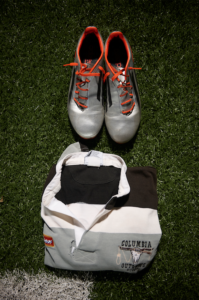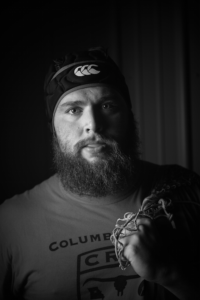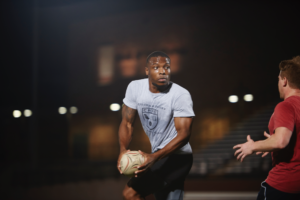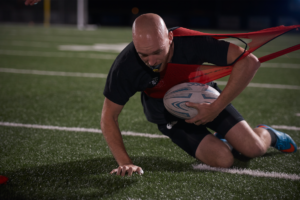Back to School
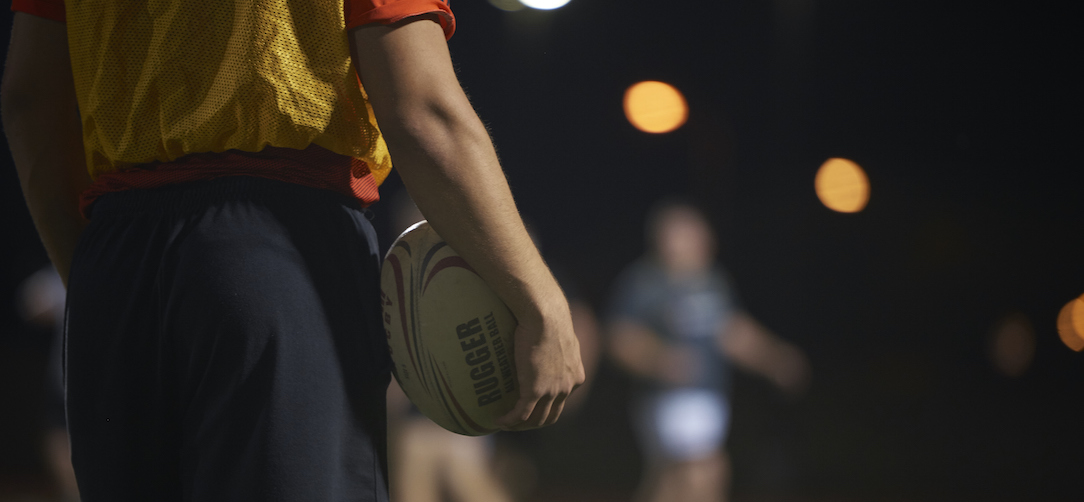
When the National Football League and First Lady Michelle Obama share a common cause, it’s a good bet that the issue is an all-encompassing one. Regardless of how you feel about either of them, their campaigns to get Americans to be more active (Play 60 and Let’s Move!, respectively) highlight the problem. We don’t exercise enough.
It is impossible to live in the United States in 2015 and avoid all lectures about bad eating habits and lack of exercise. Studies have linked greater physical activity to health benefits as diverse as lowering the risk of cardiovascular diseases to improved memory. Credible sources from the Mayo Clinic to Harvard Medical School routinely publish pieces that outline the ever expanding list of advantages of getting more exercise. We tend to tune out such information because we know the solutions and maybe even have vague plans to put them into action. Clichés such as, “I’ll start working out after New Year’s,” or “The diet starts tomorrow,” are in our lexicon for a reason. Fast-paced lives filled with other commitments often lead to putting our health on the backburner. Sitting back and hitting “next episode” on Netflix is so much easier than going to the gym, even though we know the workout would be better for us.
Don’t bail on me yet. That sounded like the start of a sermon, but I’m not here to preach about bad habits. Most people know a marathon runner or two, people who rave about “runner’s high” and the beauty of an empty trail at dawn. These are the individuals I dream of tripping down a flight of stairs. (Just kidding, runners. Don’t come after me because I don’t have the endurance to get away.) Running for an extended period of time or lifting weights at the gym, although good things in their own right, are not enough to entice everyone to be as physically active as they should. More often, as a Columbia roller derby participant named Maimy Fisher put it, we have to trick ourselves into exercising. The best way I’ve found to make that happen is to get involved with the many sports leagues and clubs across Columbia. Wait a second; don’t run away just yet. I know you’re thinking something along these lines of “But Hogan, I wasn’t an all-state pitcher in high school or a running back for Mizzou. How could I even think of joining a sports team as an adult?” That’s why I’ve done the dirty work for you by taking a tour of some of the sports (especially those less known to residents) Columbia has to offer. I wasn’t always a shining success (a total lack of athletic ability was witnessed), but if a writer can get away from his computer to try some new things, anyone can.
Down the Rabbit Hole
The first stop on my adult athletic journey was an open field at the Katy Trailhead off of Scott Boulevard for a practice with the Columbia Outlaws rugby team. Across the street, kids raced around new playground equipment at Jay Dix Station Park. Back on the east side of Scott, however, a slightly more serious group of athletes gathered, stretched and tossed around an over-inflated football without laces. Rugby enthusiasts are quick to point out that their sport developed before American football, so I should say that on Sundays in the fall, the Rams play with a rugby ball that is tapered on the ends. If you don’t follow rugby, picture it as “a cross between football, soccer and kill the man with the ball.” Coach Don Baker, an IT guy and former college football player who has been with the Outlaws for more than 20 years, gave me that description, which is a good place to start. I was immediately struck by the variety of people standing around warming up. From a few men that looked like they could suit up as linebacker for Mizzou to a 14-year-old girl who sold fundraising candy bars after practice, a wide range of shapes, sizes and ages were represented. Men with foreign accents and even a professor of physics rounded out the group.
Under the direction of Richard Ross, a short, intense man with a buzz cut who looked like he had come straight out of casting for the fiery head coach in the next inspirational sports movie, calisthenics started as practice got under way. Hitting blocking pads and pushing tackling sleds, perfect for the montage scene in said sports movie, didn’t seem much different than what you’d see at any high school football practice. Things got trickier when we began the more specific drills for forwards and backs (think linemen and skill players in football, respectively). I quickly realized I was in over my head. Coach Baker, once again, said it best when he told me, “You’ll feel like you have eight thumbs out there sometimes.” When I wasn’t accidentally tackling a teammate or stepping on someone’s hand in the ruck (a mini dog pile that took place whenever someone with the ball went down), I was pitching the ball to an empty space one of the backs on my team had vacated a second earlier.
After practice as some people scattered, others stayed around to grab a beer and hang out for a little while. Rugby has a very fraternal feel. Those who play have a common interest wherever they go. One of the great things about a close-knit sport such as this one is an instant social group to grab a drink with at the pub, crack jokes and talk trash about the last scrimmage. As a newcomer who showed little promise on the field, it was gratifying to be accepted into the fold with several members encouraging me to come back for another practice or complimenting me for attempting it in the first place.
Old Farts’ League
Waking up the morning after my first rugby practice led me to the discovery that you don’t need an expensive gym membership to get a full-body workout. Muscle groups I didn’t know existed were so sore I debated a rain check on my next athletic endeavor. Let me preface this segment by stating that soccer is, by far and away, the most popular sport in the world, so it might seem a little out of place profiled here next to some lesser known pastimes. However, most of us seem to think of eight-year-olds getting orange slices from their moms when we picture the average soccer player in Columbia. The guys at the Missouri Athletic Center, part of Wilson’s Fitness off of Forum Boulevard, have something to say about that. For the last 11 years, the MAC has hosted a men’s over 30 league (in addition to leagues for just about every age group and gender) that some affectionately refer to as the Old Farts’ League, or the OFL for short. On Wednesday nights from 7-10 p.m., members of the six-team league compete on an indoor field, talk trash and brave turf burns. Ray St. Omer, a manager at the MAC and OFL participant, graciously waved the age restriction to let me play a couple of games one Wednesday. I quickly learned that the nickname of the league was a serious misnomer as I staggered off the field during a hockey-style substitution, out of breath after a five minute spurt of bungled passes and errant shots.
Picking up the intricacies of indoor play took a little trial and error. The first time a player passed the ball off the wall to himself as he streaked by me, I was only able to turn and watch as he blasted a shot that nearly took our keeper’s head off. That wasn’t the last time my poor defense led to a goal for the opposing team, but it did illustrate a good lesson for playing any of the sports I covered: pay attention to your surroundings or you will get burned.
Don’t let my struggles give you the impression that you need Lionel Messi’s foot skills to play in the OFL. A little effort takes you a long way. Alex George, a British expatriate, lawyer, and columnist for Columbia Home commented, “What I lack in skill, which is a lot, I try and make up for by running about a lot.” If you put in a little work, the worst you’ll get is a little ribbing, and as Alex put it, “If you can’t poke fun at your mates, who can you poke fun at?”
Chicken and Pickle
After back-to-back days of intense team sports, I was looking forward to a little more relaxed night out with the Show-Me Pickleball Club. I won’t be surprised if you haven’t heard of pickleball, but you probably would have before long as it lays claim to the title of fast growing sport in America (several others share this assertion, but pickleball would appear to have as good a case as any of them). I’ll try to give a brief explanation. Played on a court slightly smaller than those used for tennis, combatants hit a wiffle ball back and forth across the net with solid paddles about twice the size of the ones you see in ping pong players’ hands. Got the idea? Alright, the best way to learn is to just get out on a court and play. Members of the club were kind enough to politely point out when I had broken a rule or made a mistake during one of the many nights they play at Albert Oakland Park. The new pickleball-specific courts there were years in the making, but they’ve helped turn a group who started with a few couples eight years ago into an ever-growing association with 120 on their regular email list. These range from younger players like my friends and I, who learned most of the rules of the game in high school P.E. classes, to an octogenarian or two who routinely whip those half their age. The rapid expansion of the sport has a lot to do with the description Carole Kennedy, one of the club’s founders, gave me. “It was easy to learn, fun to play, great exercise and an opportunity to meet new people I would have not known otherwise.”
There are many former tennis players who have picked up the sport, which with its underhand serve and smaller court is not quite as physically demanding as its better known cousin. Don’t think that means it isn’t good exercise, especially when playing opponents whose skill far exceeds your own. You might think that a couple of reasonably fit twenty-something’s (my friends Tanner and Marcus were good enough to help me test pickleball out at a recent club get-together.) would do well in a sport with a significantly higher median age, but you’d be very wrong. We quickly learned that a little skill and good technique more than made up for our perceived athletic advantages. But it was a great time, and the people we played were far too nice to rub it in our faces.
Sweet Eliza Skinner’s Bad@$* Song
If my week of touring Columbia’s fields and courts contained a few embarrassing moments, then my turn at the roller rink would fill a highlight reel of bloopers. The CoMo Derby Dames, our very own women’s flat track roller derby league, allowed me to wobble around on skates at a beginner’s practice one a Monday night. It gave me a much greater appreciation for the skill on display at the scrimmage I had watched the night before. Another sport that can’t be given justice with one of my brief explanations, roller derby involves two teams in a tight pack circling an indoor track. Three blockers for each team try to clear space for their jammer, the person who scores points, by passing members of the opposing team. Contact in the sport is a given. G-force, a Stephens College student who joined the team recently, says, “Roller derby is like rugby in stilettos.” The bouts are far more complicated than that, of course, but the great coaches at beginners’ practices (Monday nights at 7:00 p.m. at Empire Roller Rink) do a much better job of explaining it than I can.
Roller derby is easily the most colorful sport I’ve covered with members choosing fantastic, though often unprintable, derby names for referring to each other. A few that I can publish are Jo Danger, Slashtag, Phineas Rage, etc., just to give you an idea. Don’t let the bright outfits or amount of glitter fool you; these are serious athletes. Complicated plays and maneuvers (with great names such as my personal favorite, soul crushing) are tough enough on a football field with breaks in between. Attempt them at speed on roller skates, and the degree of difficulty is stepped up a notch or two. Their competitive season will be finished by the time this article is printed, but I’d highly suggest giving it a whirl at a practice or watching a scrimmage to get a better idea of the sport.
Roller derby, as a full-contact sport played almost exclusively by women, is a very interesting study. Little things like free babysitters available at practices or the fact that I was one of just two guys among 30 women on skates stuck out to me, but it means much more to those who play. G-Force gave this description of what roller derby can teach girls: “I just got hit by a truck and I’m fine and I’m going to get up and I’m going to go to practice tomorrow.”
There is more to the sport than a few empowering life lessons, though. Many of the women described the league as a community. Members pitch in when someone needs help, and being in the group means always having a friend to grab a celebratory drink with after making it through a tough week.
This was the most common theme that I encountered with every team or league with which I spent time. People don’t just play because they need the exercise but because they make great friends there. Having an instant social network through the bond of a sport that encourages teamwork and provides a readily available topic of conversation is one of the biggest benefits that playing as an adult has to offer. Whether you’re laughing together over a particularly spectacular fall in roller derby or cheering about a great shot on the pickleball court, playing sports in Columbia is just a lot of fun.
Of course, the teams I covered are far from the only groups in or around the city. There are so many other places and ways to get involved that I’d need the full magazine to profile them all. Go play volleyball at The Deuce next summer, or check out the activities the Parks and Recreation Department has running year long. At the risk of sounding like the world’s least qualified motivational speaker, get up and get out there. Columbia has a whole world of possibilities waiting for you.



